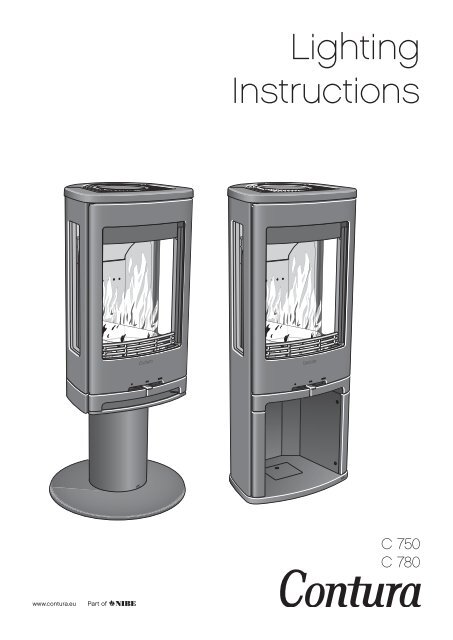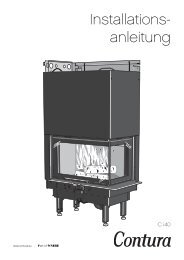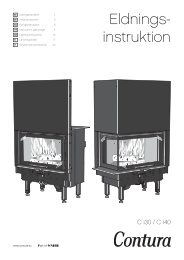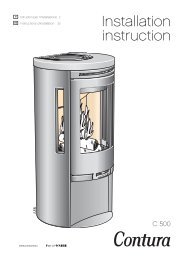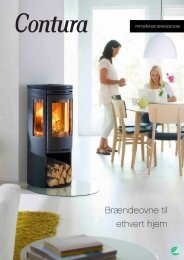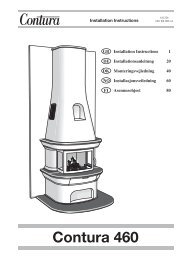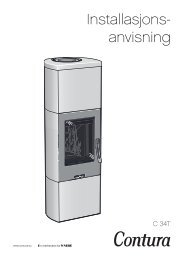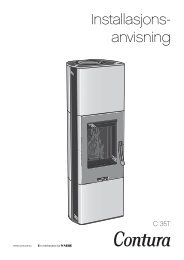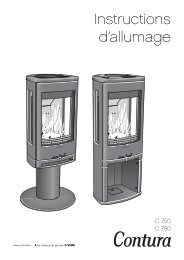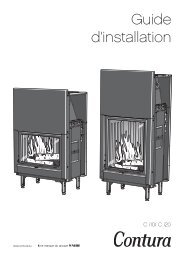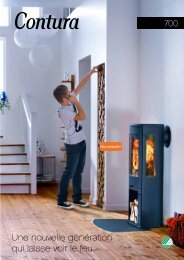Lighting Instructions - Contura stoves
Lighting Instructions - Contura stoves
Lighting Instructions - Contura stoves
Create successful ePaper yourself
Turn your PDF publications into a flip-book with our unique Google optimized e-Paper software.
www.contura.eu<br />
<strong>Lighting</strong><br />
<strong>Instructions</strong><br />
C 750<br />
C 780
GB<br />
18<br />
<strong>Lighting</strong> <strong>Instructions</strong><br />
<strong>Lighting</strong> in the<br />
right way<br />
It is important that the correct amount of wood is used, especially<br />
when lighting. If you are lighting the fire for the first time<br />
you should use a set of scales to see how much 2.0 kg kindling is.<br />
Also check what the normal and maximum weights look like.<br />
The stove may only be lit with the hatch closed.<br />
Always open the hatch carefully and slowly to prevent blow back<br />
because of the changing pressure in the stove.<br />
The function of the stove differs depending on the draft conditions<br />
in the chimney. Achieving the correct setting for the<br />
combustion air damper, suitable size and amount of wood usually<br />
takes a few attempts.<br />
Correctly sized wood<br />
Note that if too little kindling is used when lighting, or if the<br />
wood is too thickly cut, the firebox will not reach the correct<br />
operating temperature. Incorrect lighting can lead to poor combustion<br />
with heavy sooting and may result in the fire going out<br />
when the hatch is shut.<br />
Kindling: Finely chopped wood<br />
Length: 25-30 cm<br />
Diameter: 2 - 5 cm<br />
Amount per firing: 2.0 kg<br />
(approx. 10-12 finely chopped pieces)<br />
Feeding Wood: Chopped wood<br />
Length: 25-30 cm<br />
Diameter: 7 - 9 cm<br />
Normal amount: 1.3 kg/hour (2 pieces)<br />
Max amount: 2.4 kg/hour (max 3<br />
pieces per insertion. Max 1.8 kg per insertion)<br />
Important!<br />
It is important that the wood catches fire<br />
quickly. Quick lighting is achieved by opening the<br />
combustion air damper fully or by leaving the<br />
hatch ajar for a moment.<br />
Pyre lighting produces a lot of smoke and can<br />
cause quick gas ignition in the worst instance<br />
resulting in hearth damage.<br />
<strong>Lighting</strong><br />
If the house has mechanical ventilation, open a window near to<br />
the fireplace prior to lighting. Leave the window open for a few<br />
minutes until the fire has caught properly.<br />
NOTE!<br />
The left hand handle that controls the grate disc must be<br />
closed during lighting.<br />
1. Open the control for the combustion air fully.<br />
2. Insert paper or firelighters and about 2.0 kg of thinly chopped<br />
kindling into the firebox. Stack the wood crosswise.<br />
3. Light the fire.<br />
4. Set the hatch to the lighting position, that is with the lower<br />
hook against the lock roller to create a sufficient gap (see<br />
figure).<br />
5. When the fire has caught fully after approx 5-10 minutes,<br />
close the hatch completely.<br />
6. A slight amount of soot may build up on side glass during the<br />
start-up fire. This is normal and vanishes after a period.<br />
7. A fresh load of logs should not be put on until the start-up fire<br />
has become a glowing bed of embers.<br />
Adding wood<br />
1. Open the hatch a few centimetres and allow the vacuum in the<br />
firebox to equalise for a few seconds before opening the hatch<br />
fully.<br />
2. Add 2-3 logs of a combined weight of approx 1.2–1.5 kg. Lay<br />
the logs diagonally on each other so that the flame can take<br />
easily. Then close the hatch.<br />
3. The combustion damper must be completely open for 3-5<br />
minutes or until the logs turn black and catch fire. If slower<br />
combustion is then required, the supply of combustion air can<br />
be reduced. The conditions for controlling combustion vary<br />
depending on the temperature in the firebox and the draft in<br />
the chimney.<br />
4. An average energy output of 5 kW is achieved when the combustion<br />
air damper is 40% open and 2 logs weighing about<br />
1.3-1.5 kg are added once per hour.<br />
5. The lowest output of 3-4 kW is obtained when the combustion<br />
air damper is 30% open. In this operating position it is<br />
important that the combustion air damper is fully open for the<br />
first 3-5 minutes so that the wood has time to ignite properly<br />
before the supply of combustion air is reduced. A condition<br />
for regulating the output is a thick bed of embers and high<br />
temperature in the firebox. When the fire has died down to<br />
embers more wood should be added.
Choosing fuel<br />
All types of wood, such as birch,<br />
beech, oak, elm, ash, conifers and<br />
fruit trees can be used as fuel<br />
in the stove. Different types of<br />
trees have different densities, the<br />
greater the density of the wood<br />
the greater the energy value. Oak,<br />
beech and birch have the highest<br />
density.<br />
The wood’s moisture content<br />
Fresh wood is about 50 per cent water. Some of the water circulates<br />
freely between the fibres and some of the water is bound<br />
in the cells. The wood must always be dried so that the free<br />
water evaporates. The timber is ready for use when the moisture<br />
content has fallen below 20%. If wood with a higher moisture<br />
content is lit, a large part of the energy content of the wood is<br />
used boiling off the water. If the wood is damp, the combustion<br />
is also poor, layers of soot and tar build up in the chimney and<br />
could, at worst, lead to a chimney fire. In addition, it causes the<br />
glass of the stove to soot and may cause discomfort to those<br />
living nearby.<br />
To ensure thoroughly dry wood, the wood should be cut in the<br />
winter and stored, well aired, under a roof. Never cover the<br />
woodpile with a tarpaulin to the ground. The tarpaulin will then<br />
act as a sealed cover and the wood will be prevented from drying.<br />
Always store a small amount of wood indoors for several days<br />
before use, so that the surface moisture has time to evaporate.<br />
Do NOT burn the following<br />
Under no circumstances may pressure impregnated wood,<br />
painted or glued wood, chipboard, plastic or colour brochures be<br />
used as fuel in a hearth. All these materials can create hydrochloric<br />
acid and heavy metals that are damaging both to the environment<br />
and the hearth. Hydrochloric acid can also attack the steel<br />
in the chimney or the mortar in a stone built chimney.<br />
Also avoid using bark, woodchips or other extremely finely<br />
chopped wood except for lighting. Fuel of this type causes<br />
flashover resulting in too high output.<br />
Not too big fires<br />
Fires should not be too big. Large fires are uneconomical and<br />
they give off high flue gas temperatures that can damage the<br />
stove and the environment. Recommended amount of wood for<br />
normal use is 1.3 kg/hour, with the maximum permitted amount<br />
of 2.4 kg/hour and covers lighting with chopped birch wood or<br />
other broad leaf wood with a moisture content of about 18%.<br />
When lighting with the same wood amounts as above but with,<br />
for example, conifer wood, higher fireplace temperatures are<br />
achieved. The service life of the stove can be cut short if the fire<br />
is left at full combustion for long periods, and if the maximum<br />
permitted amount of wood is exceeded, parts in the stove can<br />
become damaged thus annulling the warranty.<br />
<strong>Lighting</strong> <strong>Instructions</strong><br />
When the stove is new<br />
When new, the stove may emit an odour due to excess paint and<br />
oil coating that may remain on the panels. The odour will disappear<br />
completely after several fires.<br />
Maintaining the stove<br />
The glass may become sooty with use, even if the stove is lit with<br />
dry wood with a moisture content of 15 – 20%. Regular cleaning<br />
with dry paper is usually sufficient to keep it clean. If the<br />
soot has been on the glass for a prolonged period use a cleaning<br />
agent or a special soot removal agent to remove it. Such agents<br />
can be purchased from regular hardware stores or from your<br />
local stove dealer. Never use cleaning agents that contain any<br />
abrasives, these can damage the glass.<br />
• When emptying the ash-pan, ensure that there are no glowing<br />
embers. The ash must be stored in a fireproof container with a<br />
lid for at least one week before being disposed of.<br />
• The grate and other cast iron components in the firebox can be<br />
cleaned using a wire brush.<br />
• It is important from a combustion point of view to check gaskets,<br />
as worn gaskets hinder combustion when the stove draws<br />
“extra air”.<br />
• Painted parts on the stove can be cleaned using a damp cloth,<br />
with a small amount of detergent, if necessary. Damage to<br />
painted parts, e.g. small scratches, can be rectified with <strong>Contura</strong><br />
touch-up paint. Contact your dealer.<br />
• As there is a constant large flow of air through the stove, as<br />
cold room air is drawn in and hot air released, dust can collect<br />
behind and under the stove. Therefore, the areas under and<br />
behind the stove should be regularly cleaned.<br />
• Parts located near the actual seat of the fire may require<br />
replacing. Examples of such parts are the hearth surround and<br />
grate. The service life of these parts depends on how much and<br />
how the stove is used.<br />
Hearth plate glass must<br />
be discarded as waste<br />
material together with<br />
pottery and porcelain<br />
GB<br />
19
GB<br />
20<br />
<strong>Lighting</strong> <strong>Instructions</strong><br />
Possible causes of malfunctions<br />
and how to rectify<br />
them<br />
Poor draft in the stove after new installation<br />
• Check the dimensions of the chimney so that they correspond<br />
to the ones stated in the installation instructions.<br />
• Check that there is nothing in the chimney to restrict the<br />
smoke and that no nearby buildings or trees affect the winds<br />
around the chimney.<br />
It is difficult to light the fire and the fire dies<br />
after a short time<br />
• Check that the wood is sufficiently dry.<br />
• Too great a negative pressure in the house, for example when<br />
using a kitchen extractor fan or other mechanical ventilation.<br />
Open a window near the hearth before lighting the fire. Also try<br />
lighting some newspaper and holding it up inside the firebox to<br />
get the draft going.<br />
• The supply air duct from outdoors can be partially or totally<br />
blocked. Remove the hose and try test lighting with combustion<br />
air from the room.<br />
• Check that the combustion air damper is open.<br />
• The smoke outlet of the stove may be blocked with soot, which<br />
can occur after sweeping.<br />
Lift the smoke baffle out and check.<br />
• Finally, go through the lighting instructions again.<br />
Perhaps the amount of kindling was too small and therefore<br />
the base embers were too weak and cold to light the next load<br />
of wood.<br />
Warning<br />
• During operation, the surfaces of the stove become very<br />
hot and can cause burn injury if touched.<br />
• Be aware of the strong heat radiated through the hatch<br />
glass.<br />
• Placing flammable material closer than the safe distance<br />
indicated may cause a fire.<br />
• Pyre lighting can cause quick gas ignition with the risk of<br />
damage to property and personal injury.<br />
811064 BAV SE-EX C750/780-3<br />
2011-11-29<br />
Abnormal amounts of soot form on the glass<br />
There is always a certain amount of soot on the glass and this is<br />
added to with each lighting. Soot on the glass is caused by three<br />
things:<br />
• The wood is damp, which causes poor combustion and generates<br />
a lot of smoke as a result.<br />
• Too low temperature in the firebox, which causes incomplete<br />
combustion and poor draft in the chimney.<br />
• Handling is not correct, for example the hatch was not in the<br />
lighting position for 5-10 min.<br />
Check the moisture content of the wood, ensure that you have<br />
good base embers and go through the lighting instructions one<br />
more time.<br />
Smoke odour around the stove for periods<br />
This can occur when wind blows down the chimney and most often<br />
occurs when the wind is from a particular direction. Another<br />
reason could be that the hatch was opened when there was a lot<br />
of flame.<br />
Painted parts have become discoloured<br />
If painted parts have discoloured it is due to excessive temperature<br />
in the firebox. The reason for the excessive temperature<br />
can be that the maximum amount of wood has been used or that<br />
inappropriate fuel has been used (for example building waste,<br />
large quantities of finely chopped off cuts). The warranty does<br />
not cover damage of this type. If a problem occurs that you cannot<br />
rectify yourself, contact the dealer or a chimney sweep.<br />
We hope that these lighting tips give you enjoyable, economical<br />
and problem free use of your <strong>Contura</strong> stove.<br />
Sweeping<br />
Sweeping the chimney ducts and chimney connections should<br />
be carried out by a chimney sweep. Sweep the stove by scraping<br />
and/or brushing. A soot vacuum cleaner is most appropriate<br />
however. If a chimney fire occurs or is suspected, the combustion<br />
damper and the door must be closed. If necessary, contact<br />
the fire brigade to extinguish it. The chimney must always be<br />
inspected by a chimney sweep after a chimney fire.<br />
NIBE AB· Box 134 · 285 23 Markaryd · Sweden<br />
www.contura.eu<br />
<strong>Contura</strong> reserves the right to change dimensions and procedures<br />
described in these instructions at any time without<br />
special notice. The current edition can be downloaded from<br />
www.contura.eu


